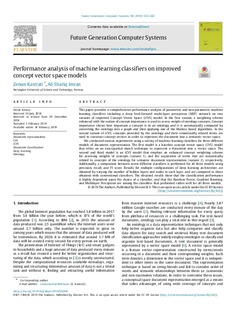| dc.contributor.author | Kastrati, Zenun | |
| dc.contributor.author | Imran, Ali Shariq | |
| dc.date.accessioned | 2020-01-30T08:26:57Z | |
| dc.date.available | 2020-01-30T08:26:57Z | |
| dc.date.created | 2019-02-19T09:36:58Z | |
| dc.date.issued | 2019 | |
| dc.identifier.citation | Future generations computer systems. 2019, 96 552-562. | nb_NO |
| dc.identifier.issn | 0167-739X | |
| dc.identifier.uri | http://hdl.handle.net/11250/2638748 | |
| dc.description.abstract | This paper provides a comprehensive performance analysis of parametric and non-parametric machine learning classifiers including a deep feed-forward multi-layer perceptron (MLP) network on two variants of improved Concept Vector Space (iCVS) model. In the first variant, a weighting scheme enhanced with the notion of concept importance is used to assess weight of ontology concepts. Concept importance shows how important a concept is in an ontology and it is automatically computed by converting the ontology into a graph and then applying one of the Markov based algorithms. In the second variant of iCVS, concepts provided by the ontology and their semantically related terms are used to construct concept vectors in order to represent the document into a semantic vector space. We conducted various experiments using a variety of machine learning classifiers for three different models of document representation. The first model is a baseline concept vector space (CVS) model that relies on an exact/partial match technique to represent a document into a vector space. The second and third model is an iCVS model that employs an enhanced concept weighting scheme for assessing weights of concepts (variant 1), and the acquisition of terms that are semantically related to concepts of the ontology for semantic document representation (variant 2), respectively. Additionally, a comparison between seven different classifiers is performed for all three models using precision, recall, and F1 score. Results for multiple configurations of deep learning architecture are obtained by varying the number of hidden layers and nodes in each layer, and are compared to those obtained with conventional classifiers. The obtained results show that the classification performance is highly dependent upon the choice of a classifier, and that the Random Forest, Gradient Boosting, and Multilayer Perceptron are among the classifiers that performed rather well for all three models. | nb_NO |
| dc.language.iso | eng | nb_NO |
| dc.publisher | Elsevier | nb_NO |
| dc.rights | Navngivelse 4.0 Internasjonal | * |
| dc.rights.uri | http://creativecommons.org/licenses/by/4.0/deed.no | * |
| dc.title | Performance analysis of machine learning classifiers on improved concept vector space models | nb_NO |
| dc.type | Journal article | nb_NO |
| dc.type | Peer reviewed | nb_NO |
| dc.description.version | publishedVersion | nb_NO |
| dc.source.pagenumber | 552-562 | nb_NO |
| dc.source.volume | 96 | nb_NO |
| dc.source.journal | Future generations computer systems | nb_NO |
| dc.identifier.doi | 10.1016/j.future.2019.02.006 | |
| dc.identifier.cristin | 1678590 | |
| dc.description.localcode | ©2019 The Authors. Published by Elsevier B.V. This is an open access article under the CC BY license (http://creativecommons.org/licenses/by/4.0/). | nb_NO |
| cristin.unitcode | 194,63,35,0 | |
| cristin.unitname | Institutt for elektroniske systemer | |
| cristin.ispublished | true | |
| cristin.fulltext | postprint | |
| cristin.qualitycode | 1 | |

